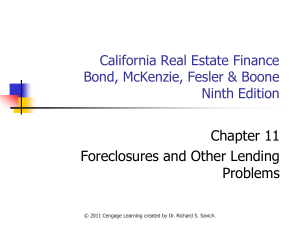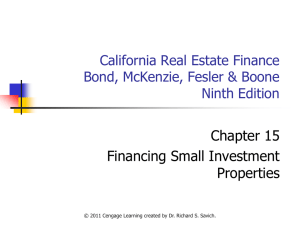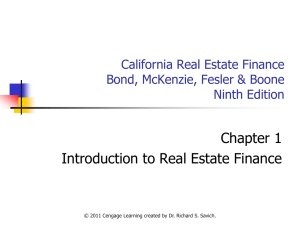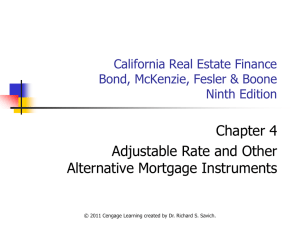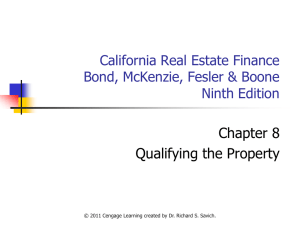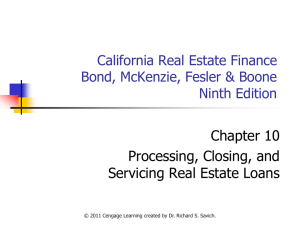California State University San Bernardino School of Business and
advertisement
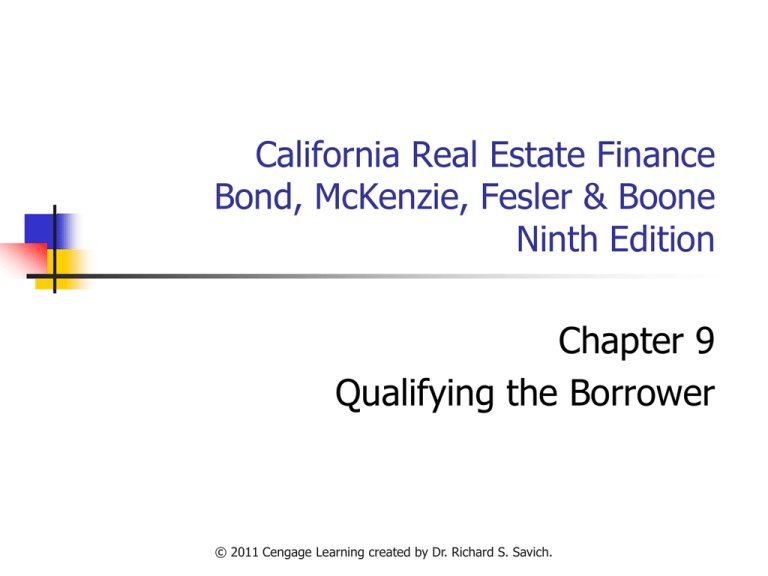
California Real Estate Finance Bond, McKenzie, Fesler & Boone Ninth Edition Chapter 9 Qualifying the Borrower © 2011 Cengage Learning created by Dr. Richard S. Savich. Objectives After completing this chapter, you should be able to: Discuss income requirements to qualify for different types of loans. Explain what effect debts have on a prospective borrower’s qualifications. Describe how lenders analyze stability of income. Explain why lenders are concerned about borrowers’ credit history and credit score. Draw up a list of things that real estate agents can do to help clients to obtain financing. © 2011 Cengage Learning created by Dr. Richard S. Savich. Outline How Lenders Qualify Prospective Borrowers Ability or Capacity to Pay: A Case History Capacity to Pay Qualifying Under Government-Backed Loans What is Income? Co-Borrowing After Income, What Then? Desire to Pay Working with Lenders © 2011 Cengage Learning created by Dr. Richard S. Savich. How Lenders Qualify Prospective Borrowers Ability or capacity to pay Earn enough Steady source Enough cash Other assets Desire or willingness to pay Continue making payments? Credit Score Fannie Mae’s Desktop Underwriting Freddie Mac’s Loan Prospector © 2011 Cengage Learning created by Dr. Richard S. Savich. Ability or Capacity to Pay: A Case History See Case on pp. 236-237. Why qualify borrowers? Just take back house Lenders are in money business, not real estate business High LTV ratios Borrower could get “upside down” If a loan is not sound for the borrower, it is not sound for the lender © 2011 Cengage Learning created by Dr. Richard S. Savich. Capacity to Pay Income ratios Include PITI (FHA wants UFMIP & MMI also, Condos need HOA) < 33% of gross income (See next slide for calculations) But some go 45-50% Compensating factors Substantial cushion/reserve Co-borrower Higher earnings potential Large down payment Currently making rent payments at same level Debts Short term debts ignored Long term (10 months or longer to pay off) Includes alimony and child support © 2011 Cengage Learning created by Dr. Richard S. Savich. © 2011 Cengage Learning created by Dr. Richard S. Savich. Qualifying Under GovernmentBacked Loans (FHA) Same procedure as conventional lenders Except front-end ratio <29% And back-end ratio <41% © 2011 Cengage Learning created by Dr. Richard S. Savich. Qualifying Under GovernmentBacked Loans (DVA) Residual Income Method Start with gross income Subtract all taxes To get Net Take-Home Pay Subtract housing payment and fixed obligations Remainder is Residual Income See next slide for example Figure 9.3 Is this enough to provide for the needs of the family? Family size Geographic area Price of home and neighborhood Living pattern Income Ratio Application PITI Long term debt All divided by gross monthly income Should be < 41% Compensating factors Down payment No vehicle payments Few credit cards Substantial net worth Stable work history © 2011 Cengage Learning created by Dr. Richard S. Savich. Figure 9.3 Summary of DVA qualifying procedure Allowable gross income $5,300 Less: Federal income tax 677 State income tax 172 Social Security or retirement 382 Net take-home pay $4,069 Housing payment and fixed obligations Principal and interest $ 1,288 Property taxes 312 Homeowner’s insurance 66 Total mortgage payment $1,666 Maintenance/utilities (@14 cents/sq. ft.) Total housing expense 140 $1,806 Alimony and child support 0 Long-term debts $ 375 Job-related expense 0 Total housing and fixed obligations Analysis $2,181 Net take-home pay $4,069 Less: Housing and fixed expenses Residual income 2,181 $1,888 © 2011 Cengage Learning created by Dr. Richard S. Savich. Qualifying Under GovernmentBacked Loans (Cal Vet) Adjusted Gross Income Remaining Income Gross income Less federal and state income taxes Less Social Security Equals AGI Less house payments (PITI plus maintenance and utilities) Less long term debts (> 1 year to pay off) Equals RI RI/AGI = Residual Should be >50% of AGI © 2011 Cengage Learning created by Dr. Richard S. Savich. What is Income? Salaries Commissions less expenses Overtime (not usually) Bonuses Part-Time Work Spousal/Alimony and Child Support Need not be revealed or questioned Payment can be questioned Pensions and Social Security Extra military pay (including free medical) Income from real estate Self-Employment All these need at least two year history © 2011 Cengage Learning created by Dr. Richard S. Savich. Co-Borrowing Co-mortgagors might help with income Co-signers are on note, but not on title Lenders do not like this © 2011 Cengage Learning created by Dr. Richard S. Savich. After Income, What Then? Length of time on job Type of job Age of borrower > 2 years No longer a factor Other assets Gifts from parents for down payment Supply “gift letter” © 2011 Cengage Learning created by Dr. Richard S. Savich. Desire to Pay Past payment record Bankruptcy Chapter 13 better than Chapter 7 Wait 3-4 years Credit scores (Range from 300 - 900) 720 required to get best loan terms and rates Equifax Experian TransUnion Affected by Late payments Collections Judgments Write offs Number of credit inquiries Too many unused accounts Under Federal Fair and Accurate Credit Transaction (FACT) Act, everyone is entitled to a free copy of their credit report once a year © 2011 Cengage Learning created by Dr. Richard S. Savich. Motivation Down payment Reason for buying © 2011 Cengage Learning created by Dr. Richard S. Savich. Working with Lenders Possibility Honesty Cooperation Lender input Government-backed loans Exceptions and cover letters See www.myfico.com for more information © 2011 Cengage Learning created by Dr. Richard S. Savich. Questions and Comments? © 2011 Cengage Learning created by Dr. Richard S. Savich.
